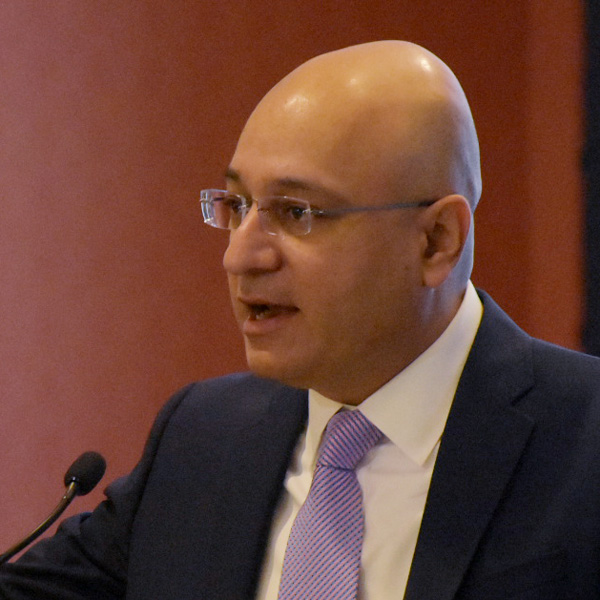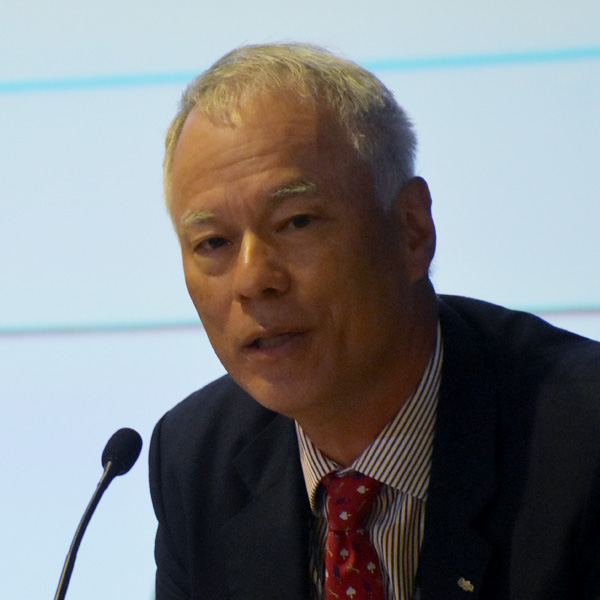
 Manu Asthana, PJM CEO | © RTO Insider LLC
Manu Asthana, PJM CEO | © RTO Insider LLC
VALLEY FORGE, Pa. — PJM and its stakeholder body were not perfect in solving complex issues in 2021, but the difficult debates led a long list of accomplishments CEO Manu Asthana said Tuesday at the keynote address of the Annual Meeting of Members.
The event at the PJM campus marked the first time in more than two years that stakeholders joined for an in-person discussion after the COVID-19 pandemic forced the RTO into remote meetings. It also was the first in-person Annual Meeting since 2019 in Cambridge, Md.
Asthana said the accomplishments of PJM and its members in a remote setting over the last year showed that they are committed to the three-prong strategic pillars laid out in December in the RTO’s paper, “Energy Transition in PJM: Frameworks for Analysis”: the facilitation of decarbonization policies in a cost-effective way through competitive markets while still maintaining reliability; doing the necessary work to “herald” the grid of the future; and creating an environment of innovation. (See PJM Energy Transition Study Released.)
“I think the stakeholder body works together well when we can show up with respect to each other’s expertise; when we can show up and assume positive intent from each other and from PJM,” Asthana said. “I think we have the power to solve really complex problems.”
2021 in Review
Asthana called 2021 a “busy year” for the RTO, stakeholders and the energy industry in general.
“Reliability is our No. 1 priority, and I feel great about how collectively we have performed against that priority over the last year,” Asthana said.
 PJM staff and stakeholders at the Annual Meeting of Members: (from left) Chris O’Hara, PJM; Dave Anders, PJM; Erik Heinle, D.C. OPC; Becky Robinson, Vistra; Manu Asthana, PJM.
PJM staff and stakeholders at the Annual Meeting of Members: (from left) Chris O’Hara, PJM; Dave Anders, PJM; Erik Heinle, D.C. OPC; Becky Robinson, Vistra; Manu Asthana, PJM.
He harkened back to the February 2021 winter storm and its impacts on his home state of Texas.
“It was a sobering reminder of the importance of what we do, the importance of keeping the lights on for the 65 million people who we serve, which is our No. 1 purpose,” Asthana said. “I felt the weight since I took this job of that responsibility; after [Winter Storm] Uri, I have felt it even more.”
PJM and its members have seen an “immense amount of work” over the last year, Asthana said, with the workload continuing to “accelerate” because of the energy transition to renewable resources and the growing number of them in the interconnection queue.
Asthana highlighted changes to the minimum offer price rule, updated effective load-carrying capability rules, and the work started at the Resource Adequacy Senior Task Force to attempt to design a clean energy or state policy procurement market.
The first-ever use of the State Agreement Approach (SAA) with New Jersey on developing offshore wind plans and becoming the first RTO to publish marginal emissions data on a nodal basis were also highlights. Asthana said the SAA is serving as a model for RTOs and ISOs around the country.
For 2022, Asthana said, PJM and stakeholders need to continue the successes of the last year by making sure the work of the RASTF is done correctly.
“I think it’s really important to get the word of the RASTF right because we’re asking things of our market that we didn’t used to ask,” Asthana said. “And we’re asking them to facilitate the policies of 13 different states and D.C. And those policies are starting to diverge.”
Asthana finished his remarks by acknowledging PJM’s two major anniversaries for 2022: 95 years as an organization, and 25 years since it FERC designated it an ISO. (It became an RTO in 2002.)
 Mark Takahashi, PJM Board of Managers | © RTO Insider LLC
Mark Takahashi, PJM Board of Managers | © RTO Insider LLC
“This 95 years, this 25 years, belongs as much to all of you as it belongs to the people that work at PJM. I want to say thank you for supporting the RTO and for supporting our important mission and helping us get better over the last 95 years.”
PJM also announced that three of its Board of Managers were re-elected to their positions.
Terry Blackwell, O.H. Dean Oskvig and Mark Takahashi will serve additional three-year terms. Takahashi joined the board in 2016 and currently serves as chair. Blackwell joined in 2015, and Oskvig joined in 2016.

